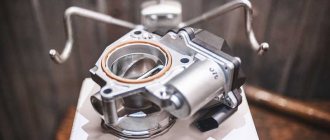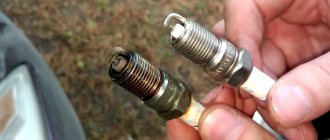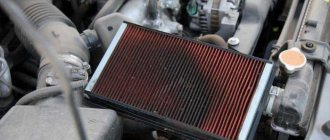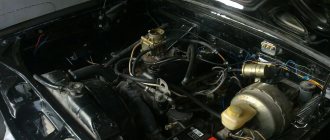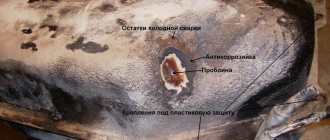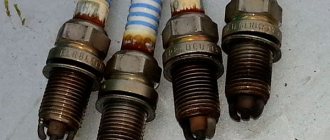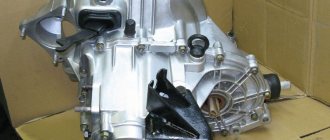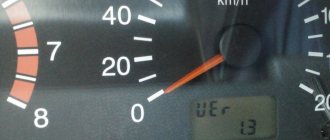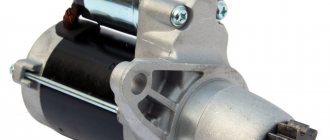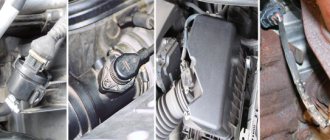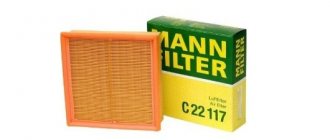The air filter is an important consumable component that protects key engine components from dirt, dust, stones, insects and other debris that can harm the stable operation of the engine. The air filter should be changed every 10-15 thousand kilometers, or in accordance with the manufacturer's recommendations.
When replacing, the driver may encounter the problem that traces of engine oil appear on the filter element. In some situations, the driver pays attention to this due to symptoms of improper operation of the air filter, which has not yet completed its required mileage. It is prohibited to operate a filter that contains traces of engine oil for reasons of safety of the car engine. At the same time, installing a new filter element will not get rid of the problem, since after a few kilometers of run oil traces will appear on it. Before changing an air filter that has traces of oil on it, you should find the problem and fix it.
Question No. 1: why is the car air filter covered in oil and the reasons for this phenomenon?
This question arises among some car enthusiasts during the next air filter replacement; moreover, this fact causes confusion among many. According to their opinion, there can be no connection between the lubrication and air filtration systems of internal combustion engines. However, even minimal knowledge of the principles of operation of the power unit makes it possible to refute this concept.
In fact, the answer to the riddle of why the air filter is in oil is simple - in addition to the main air flow, crankcase gases also pass through the filter element. Moreover, their concentration is directly proportional to engine wear. Serious problems with the cylinder-piston group lead to the penetration of lubricating fluid into the crankcase and the appearance of excess pressure, which destroys the seals. All these factors contribute to unwanted penetration of lubricant into the air filter.
Based on the experience of practicing craftsmen, we can outline the most common reasons why oil ends up in the filter element:
- High levels of wear and coking of the piston rings, which does not allow excess lubricant to be effectively removed from the cylinder walls, and the substance penetrates into the crankcase.
- The oil deflector drain is clogged and the remaining lubricant cannot return to the crankcase, so the air filter is filled with oil supplied with crankcase gases.
- Clogged crankcase gas throttle outlet hose.
- The filter element loses its performance characteristics; in other words, the air filter becomes contaminated with dust. Due to the insufficient volume of incoming air, the engine begins to compensate for this parameter by suction from the crankcase.
Faulty Defender
Motorists rarely check this part. If the engine begins to seriously malfunction, then the gaze goes under the hood. So, we decided to replace the consumables. The deadline has come. They look, and there is oil in the air filter. Of course, this is an unpleasant symptom. Are you starting to wonder why oil gets into the air filter? If you remember the structure of an internal combustion engine, you can understand how oil can get into the cleaning element. The fact is that as a result of fuel combustion, crankcase gases are formed. After this, they should completely leave the cylinders, but this does not always happen. Reasons that can lead to this: serious engine wear; stuck piston rings or coked engine.
Excessive pressure leads to the destruction of oil seals; faulty ones cause the engine to “throw” oil. So, the presence of something extra in the filter is unlikely to make the car owner smile. On the contrary, it will make you think. So, this could be due to:
- Stuck piston rings: leads to incomplete collection of excess oil that ends up in the crankcase from the cylinder. Due to excessive pressure, the lubricant is squeezed out.
- Clogged drain of the central oil deflector. Excess oil cannot return to the crankcase, escaping with gases.
- A clogged hose or channel for venting crankcase gases beyond the throttle boundaries: oil ends up in the air filter along with the gases.
- Clogged filter element: the motor does not have enough air.
Main reasons
Similar malfunctions can occur in the engine design of a motorcycle, scooter, walk-behind tractor, and even a regular lawn mower. But since we have an automobile site, we will talk specifically about cars.
There are several reasons for the occurrence of these symptoms.
Most often, motorists are faced with the following factors:
Replacing the engine with a more powerful one: all the design nuances
Category: Instructions
- the oil deflector drain becomes clogged;
- piston rings are stuck;
- rings wear out or become deformed;
- exhaust gas exhaust hoses fail;
- these hoses simply become clogged;
- the air filter itself becomes dirty;
- There is a confluence of several factors.
Now we should briefly go through all the reasons considered. Usually they are observed one at a time. Although it is possible that 2-3 factors simultaneously led to a similar problem. During testing and diagnostics you will be able to understand this.
The most common faults
Common problems with a faulty air filter pipe include:
- mechanical damage;
- sagging (weakened) corrugation fastenings;
- the appearance of technical fluid (oil) in the pipe and air filter.
It is necessary to dwell on each problem and reveal its essence.
Mechanical damage
If the intake pipe of the air filter located between the power unit and the filter element is subjected to mechanical stress and becomes deformed or bursts, then polluted air will enter the engine without undergoing mandatory cleaning.
The pipe in question is made of rubber and often breaks. It is constantly exposed to stones, sand and hot oil.
Therefore, it should be treated very carefully. If it bursts, the problems discussed earlier will arise.
Loose corrugation fastenings
What happens in this case? That's right, the seal is broken. In this case, the raw air mass is sucked into the cylinder block and concentrates on the cylinder head valves and piston rings in the form of soot.
It mixes with unburnt fuel, forming a viscous abrasive substance. This substance negatively affects the elements and components of the power unit, reducing their service life.
Oil in the pipe and air filter
The reason for oil penetration into the air duct is a malfunction of other vehicle systems. Oil penetrates the pipe and filter element through the breather.
It settles on the walls of the air duct in the form of vapor, gradually turning into a mass of thick consistency.
Diagnostics
If on a carburetor or injector oil is thrown into the air cleaning device and the entire filter is in lubricant, the car owner needs to diagnose the problem. First of all, we recommend checking the functionality of the filter device itself. The service life of the element is 10-15 thousand kilometers, while the service life is affected by the pollution of the city in which the car is used. If the filter mechanism is relatively new, it is necessary to diagnose compression in the cylinders of the power unit.
This is done like this:
- First, check the valve clearances. If necessary, adjust them.
- Start the car engine and warm it up. To obtain more accurate compression data, the temperature of the power unit should be about 70-80 degrees.
- Stop the engine and open the hood. Disconnect the high-voltage wires from the spark plugs, and then unscrew them with a special wrench. When dismantling, the spark plugs will be hot, be careful and wear gloves.
- Loosen the clamp and disconnect the fuel pipe. To prevent fuel leakage, turn it off.
- Find the location where the ignition coil is installed in the car; you need to disconnect the central cable from it.
- Now the compressor itself must be installed in the spark plug socket. Diagnostics of the pressure parameter is carried out on each cylinder separately. The check starts from the first cylinder.
- Help from another person will be required. The assistant needs to sit behind the wheel and turn the key in the ignition for the starter to start working. There is no need to start the internal combustion engine. When the crankshaft is cranked, diagnostic results will appear on the compressor pressure gauge.
- The readings obtained must be recorded on a sheet. The checking procedure is carried out on each cylinder in the same way. If the power unit is operating correctly, the minimum compression parameter will be about 10 kg/cm2. The discrepancy between different engine cylinders should be no more than 1 kg/cm2. If diagnostics have shown that the compression level in some cylinders is better than in others, then most likely the reason for the release of engine fluid lies in poor fit of the internal combustion engine valves to the seats. The problem may be worn compression rings or poor cylinder head gasket seals.
- If the diagnostics show that the pressure in each of the cylinders is different or is less than the optimal parameter of 10 kg/cm2, the engine requires a major overhaul. It is necessary to perform a more detailed check of the engine operation. It will be necessary to grind the valves, change the piston rings or cylinder head gasket.
Check the working condition of the crankcase gas outlet pipes from the device. If they are too clogged, they need to be washed or replaced.
Oil gets into the air filter - video
Another similar view on this problem was expressed by a car mechanic I know:
The air filter must be removed first, then you need to wipe everything dry with a clean rag and install a new filter. Stores also sell special aerosol cans called brake cleaner, which contain a special liquid that perfectly removes oil stains and stains.
This method is the most effective and simple, but if it does not help, then you need to check the condition of the breather, most likely it is clogged. To find out whether oil continues to get into the filter, you need to check the oil level in the engine and measure the compression. Determining the source of the problem will help eliminate it effectively in the shortest possible time. The pipes that go to the air filter can allow oil to pass into it. If the pressure of crankcase gases is increased, then this problem begins.
The oil filler cap must be carefully removed if ventilation is impaired. Air circulation should then be restored. The engine must be turned off when performing this procedure. The lid must then be slammed shut and the engine turned on. At this stage, you need to unscrew the spark plug from the first cylinder, access to air will appear. The guides and intake valves do not function properly if air is moving towards the carburetor.
It is necessary to check the compression; if air flows to the muffler, the exhaust valves may not work properly. And so, after some advice, we can summarize the reasons for this problem:
- the breather is not working properly
- the intake and exhaust valves are faulty,
- there is very high gas pressure in the crankcase,
- compression problems.
It is necessary to conduct a small experiment in order to find out whether the oil accurately enters the air filter. It is necessary to lengthen the crankcase air ventilation outlet; it must pass below the engine. The problem may be with the ventilation system if the air filter remains clean after some time. This suggests that you cannot delay in troubleshooting.
Another way to solve the problem is to install another oil deflector under the cylinder head cover. A metal sponge made of metal for cleaning the throttle valve can be used as an oil deflector. You can purchase such sponges at any hardware store.
The problem will be eliminated, and the idle speed will become smoother after this procedure. To reduce your financial expenses, you need to prevent such problems. The air filter must be replaced with a new one in time and prevent further damage. It is also worth remembering that all characteristics of a car engine must be taken into account when choosing a new air filter. If the cartridge has breaks or other damage, the air filter must be replaced immediately.
Vote, did you like the article?
Briefly about the prevention of ICE
In conclusion, we will consider some aspects of preventive measures designed to prevent the moment when the car’s air filter fills with oil due to defects in the cylinder-piston group. Their essence lies in the following points:
- Change the lubricant more often; if the manufacturer recommends, for example, changing it after 15,000 km, then you do not need to maintain this particular interval - it is better to change it after 10,000 km. The fact is that the timing depends on many parameters, including seasonality, operating conditions, and the quality of fuels and lubricants.
- Purchase only certified lubricants.
- Be sure to combine an oil change with the installation of new air and oil filters.
- Use only high-quality fuel from proven brands.
These simple rules will improve the performance of the motor and also increase its service life. It would not be superfluous to install a universal oil catcher on the crankcase gas supply tube. Its price is low, but the effect of its use will not be long in coming - the filter element will be reliably protected from lubricant penetration.
How to remove oil
The main methods used to fix the problem:
More often, oil enters the filter along with the gases that pass through it. To solve this problem, you will need to remove the hose from the filter, rinse it from impurities and debris that have clogged the element, and then install the hose back. If this does not help, you will have to check the throttle valve. Carbon deposits and debris often prevent the part from working properly, causing high pressure in the engine. More often the problem is solved by repairing the damper or replacing it.
Slag can accumulate in the vehicle's oil slinger; To fix the problem, you will need to clean this element and install an additional oil deflector.
If the air filter is damaged or clogged, it may itself be the cause of oil. In this case, the filter can be replaced or cleaned.
If the problem has not been solved, then the cause will have to be looked for in the engine. This means that the car will require more serious repairs: replacing oil rings or other types of manipulation.
What to do if water gets into the gas tank? How to remove it - see this material.
Oil in the air filter pipes often appears due to poor compression in the car’s cylinders. You can check how the cylinders work by warming up the engine to operating temperature. If the values are not the same, then the engine requires repair. This problem occurs especially often in older cars.
The owner will also need to check the valve clearances. If they are too large, oil will begin to appear in the air filter. The same applies to replacing oil seals. In a garage environment, it is difficult to determine the cause of a vehicle malfunction. Most owners turn to a car service center, where diagnostics are carried out by technicians using special equipment.
If your car's engine is worn out, you can delay major repairs by doing the following:
- The hose conducting gases through the crankcase must be removed.
- A plug is installed on the fitting.
- The crankcase is ventilated through an extended length hose, which is passed through the bottom of the engine.
- Replace engine lubricant.
What is the problem?
The presence of oil on the air filter itself will not cause harm, but it can serve as an alarming symptom that the need for a major engine overhaul is approaching, and this procedure is labor-intensive and expensive. The appearance of a sign requires prompt contact to a car service for in-depth diagnostics of the car.
Key Features
When checking engine compression, you must remember that a discrepancy of one or two units is acceptable. If the compression in the cylinders is very different from each other, then this indicates that the valves are burnt out or the rings are not pressed tightly, and it’s time to change them.
It is worth paying attention to what color the car's exhaust gases are. If the piston group is heavily worn, the smoke will take on a bluish tint.
If, after checking the compression in the cylinders, no serious deviations from the norm could be detected, then there is no cause for concern, and the oil most likely comes through the crankcase due to a hose clogged with debris. The hoses are easy to clean or replace.
See what you can do if oil gets into the air filter
If oil is found in the air filter, you should carefully check the entire system. Even if the car is new, this does not guarantee that the valves or rings are in good condition. The problem in the initial stage can be solved with minimal expenditure of money and effort, but the neglected version will be very expensive to repair.
The road is clear
Now let’s take a closer look at how this happens, how the oil gets from the crankcase to the filter.
- Due to excess pressure, oil particles break out of the crankcase.
- Initially they get inside the oil deflector.
- Next, overcoming the valve, they “move” inside the pipe, which is connected to the purifier body.
- Result: oil traces appear in the filter.
Now let’s look at diagnostics, as well as correction of typical situations using specific examples with cars. That is, let's see how the search for the cause of oil particles getting into the filter should go.
How to treat it
Here’s a common case: a car enthusiast discovered oil in the air filter of a VAZ 2109. You need to figure out what the essence of the problem is. If you do not pay attention to the situation, the consequences can be disastrous, including major engine repairs.
To find out the answer to the car enthusiast’s sacramental question – “why does it throw oil directly into the air filter?” – initially we prepare everything that may be useful to us:
- a pressure gauge, more precisely, a compression gauge, the simplest one equipped with a flexible tube with a thread at the end;
- set of wrenches;
- spark plug key;
- rags, gasoline, brush.
To find out why the engine drives oil into the filter, we proceed as follows.
- We look at the exhaust smoke – we don’t notice a black or blue tint. This means that stuck piston rings can most likely be ruled out.
- We check the oil level with a dipstick - it turns out that there is no excess oil product either.
- We measure the compression of the cylinders. To do this, we unscrew the spark plugs on a warm engine, according to the relevant instructions attached to the compression gauge, take measurements on each of the cylinders, and check the passport data. We find out that the compression corresponds to the standard specified in the car’s registration certificate.
- We notice that there is also oil in the filter pipe, which extends from the breather.
- We dismantle the breather, that is, the crankcase valve. To do this, first remove the valve cover.
- Remove two bolts from the valve cover.
- We take it out, then clean the stack of oil deflector screens with gasoline. We also wash the breather itself with gasoline.
- We perform assembly in reverse order.
This is how you can understand why the VAZ 2109 has oil in the filter, and then fix the problem. Let us add that some car owners simply remove the breather tube from the air intake duct, then lower it down under the engine. However, this serves only as a temporary measure and does not in any way solve the problem itself.
Next we consider another typical case. Suppose there is oil in the air filter of a VAZ 2110 car. We have the following at hand:
- compression gauge;
- spark plug key;
- set of keys, screwdrivers.
As described earlier, we first look at the exhaust and also measure the compression. If the compression is low, we recommend disassembling, diagnosing and repairing the engine. But, let’s say, here, too, the compression turned out to be normal. Then we proceed as follows.
- We find out that there are no deposits at the breather pipe, and that the air-cleaning element has been replaced recently.
- We remember that the engine usually has difficulty starting.
- As an option, we clean the throttle assembly.
- To do this, first remove the decorative engine cover.
- We dismantle the air pipe ventilation hose and find traces of oil inside it. The throttle body's ventilation duct is probably clogged.
- Having loosened the clamps, remove the hoses of the throttle heating channel, as well as the gas tank ventilation system.
- We dismantle the cable and also unscrew the two nuts of the throttle assembly.
- We thoroughly wash the removed throttle assembly with gasoline or a special product with partial disassembly.
Why repair or replace a damaged pipe?
If the inlet pipe of the air filter, located between the latter and the engine, is damaged, uncleaned air that has not been filtered will be sucked into the engine. What this can lead to was discussed above. The consequences of failure of the air intake pipe in front of the filter are also obvious. Firstly, it will take air from a place not intended by the designers, which means it is either not cool enough or not clean enough. In the second case, the filter will become dirty faster and will not be able to provide the engine with the required volume of air - the engine will begin to “suffocate”, its power will decrease. Secondly, a torn pipe, and especially one shortened compared to the original length, will not be able to fully protect the filter from road debris and dirt, which, again, will lead to rapid clogging of the filter element. This function of the air intake pipe was mentioned above.
Purchasing and installing a new air intake pipe will cost much less than frequently replacing the air filter. The cost of the pipe between the filter and the engine is nothing compared to the cost of repairing the latter. Even in extreme cases, when it is not possible to buy or there is no high-quality, necessary product on sale, you cannot leave the pipe in a deplorable condition. You should try to repair it using tape, adhesive insulating tape, cuttings or fragments of other pipes.
When should you turn to professionals?
If the driver does not have much experience in maintaining his vehicle, it is better to turn to professional mechanics. Otherwise, repairs will cost even more in the future.
For example, if it is necessary to replace the Lanos 1.6 air filter pipe with a sensor, you must first select the correct part, and then install it correctly in the system. If your qualification level is insufficient, you can make a mistake. This will negatively affect the performance of the car.
Other faults
Causes and solutions
The muffler fires during the factory, and the fire is visible
- Faulty spark plugs (change spark plugs)
- The mixture in the cylinders does not burn completely (cleaning or replacing air filters)
- Problems with the exhaust valve (incomplete closure, wear, burnt seat); burning mixture entering the muffler (check that the carburetor settings are correct)
- A flash in the muffler occurs due to the knocking down of the valve opening angle, or the knocking down of the ignition angle when the spark plug flares with the exhaust valve slightly open (check the degree of tightness of the valve to the seat; make sure that the valve timing and ignition timing are set correctly);
A minute after starting and warming up, the gas generator stalls, while gasoline flows normally and the air filter is not dirty.
Not enough oil (add oil to the level indicated on the label)
In a practically new generator, when it is put into operating mode, there is no current
Excess starting current, i.e. connection to the generator of devices that require more energy when starting up than the generator produces
A gas generator with a service life of 1 year has gasoline leaking from the air filter.
Clogging or oxidation of the carburetor (if clogged, the carburetor must be cleaned; if oxidized, replace it)
The engine hour sensor does not work (replace the sensor)
When the generator was operating above the permissible power, the voltage was lost, but the engine was running properly
Burnout of diodes or windings (replacement of failed elements)
The gas generator stalls a minute after starting; this goes on all the time
- Lack of fuel (check fuel level)
- Before putting the gas generator away for winter storage, the fuel was not drained (replacing the carburetor)
A new gas generator starts to experience interruptions two minutes after starting, after which it stalls
Lack of fuel (check gasoline level)
While the generator is running, the voltage suddenly drops. When measuring, the output voltage level is 60-63 volts
Burnt out diode bridge or starter (part replacement)
Immediately after starting, the gas generator stalls and the muffler fires. Oil level is normal
Faulty spark plugs (replace spark plugs)
Oil drips from the exhaust pipe of a gas generator. The speed is normal
Poor engine compression (replacing rings)
In this article, we talked only about the most common breakdowns in a home power plant. We recommend contacting our service center for professional technical support. We carry out all types quickly and efficiently. Because we have the necessary spare parts in our warehouse.
The air filter is designed to remove mechanical particles from the air. Due to the fine-porous structure of the filter element, dust and dirt are retained on the filter, and thus purified air is supplied to the engine fuel-air system. The more intensively the generator is operated, the greater the volume of air will pass through the air filter and, accordingly, the more intensively air pollutants will be adjusted in the structure of the filter material.
Most generator owners greatly underestimate the importance of promptly cleaning or replacing a worn out fuel filter. When the air filter is dirty, damaged or ruptured, it is unable to effectively clean the air, which means that dust will enter the carburetor, and then directly into the piston group of the engine, the abrasive properties of which will contribute to the rapid failure of the most important and most expensive components of the generator
Even a slightly dirty air filter leads to a significant reduction in engine power, excessive fuel consumption, and as a result, overheating of the engine and a significant increase in exhaust toxicity.
conclusions
It turns out that the air filter pipe is not a weak link in the chain of stable operation of the power unit. On the contrary, the corrugation plays a certain role in the reliable operation of the motor. The passage of purified air to the engine largely depends on its strength and integrity.
In addition, this is one of the “points” for trapping dirt and dust. You can't do without it. Replacing an element is not difficult.
Installation and dismantling can be carried out independently or during scheduled maintenance or unscheduled technical operations.
When replacing yourself, the main thing is to choose the right corrugation. You need to pay special attention to this, good luck.
- Air filter pipe
- 1. What is the purpose of the air filter bellows?
- 2. Pipe malfunctions
- 2.1. Mechanical damage
- 2.2. Loosening fasteners
- 3. Oil in the bellows and air filter
- 3.1. Reasons for getting there
- 3.2 Ways to solve the problem
- 4. Replacing the corrugation
Among most motorists, there is a mistaken opinion that the air filter pipe (or, as it is also called, the corrugation) is not such an important part that does not need to be given special attention, since any malfunction cannot significantly affect the operation of the entire air filter. Alas, this is not at all true, and we will now prove it to you. In this article we will try to understand what functions the air filter pipe itself performs, what malfunctions it can be subject to, and also consider options for replacing and repairing a faulty pipe.
Why do you need an air filter bellows?
It is known that in order for the engine to work, and more specifically, to receive the air-fuel mixture necessary for this, it is customary to use air purified from dust and other harmful components of the environment, such as insects or abrasive dirt.
And no wonder, because if, for example, dust particles get into the cylinder, they can seriously damage its rings or surface. This will lead to a violation of the contact density between these parts. This malfunction can cause a decrease in compression, and as a result, a decrease in the power of the engine itself.
Moreover, oil may stagnate in the resulting scratches in the cylinder, which will burn and lead to the formation of smoke in the exhaust gases, as well as the need to constantly add lubricant due to its burnout.
Air is supplied from the filter to the engine through a pipe. Air transportation is one of the most important functions of the pipe. On cars that are equipped with a filter located near the radiator frame, it is also common to install air intake pipes, which are located in the corner between the fender and the front panel of the engine compartment.
As a rule, such pipes are connected to the inlet of the filter and are located so that the cleanest and coolest air can freely flow into them. To do this, their air intake ends are placed in front of the radiator and placed in such a way that they are higher and away from the wheels and confined spaces, if a filter is installed in it, and where circulation is disrupted. This placement ensures not only a good supply of cooled air, but also protects the filter from road dirt and debris.
In this case, air intake is carried out in the most efficient and safe way, preventing dirt or dust from entering the engine compartment. But if there are still dust particles in the incoming air, they will linger in the intake pipe and then fall out of there themselves. All this will help the air filter remain in good condition and operational until the end of its service life.
Pipe malfunctions
Now let's take a look at the most common malfunctions of the air filter pipe. These include:
1. Damage due to mechanical impact.
2. Loose fittings of the pipe.
3. Presence of oil in the bellows and air filter.
Now let's look at each of the faults in more detail.
2.1. Mechanical damage
If the air filter inlet pipe, which is located between the filter itself and the engine, has been subjected to any mechanical damage, unclean air that has not been filtered will be sucked into the engine.
Do I need to replace a worn or damaged pipe?
Some motorists believe that you can drive with a cracked pipe, but this position is fundamentally wrong. Firstly, a damaged pipe will not be able to supply clean air to the engine. After all, through the gap, air from under the hood will enter it, which has not been filtered, and therefore carries abrasive particles (which, as mentioned, can quickly damage the engine).
Replacing the pipe
Secondly, driving with a damaged corrugation also leads to faster wear of the air filter; it will have to be changed much more often. That is why a damaged or worn pipe should be immediately replaced with a new one.
Where to do the work
You can do the work yourself. This can be done in the garage or at +t0 outside. Just watch the video and purchase the original corrugation recommended for use by the manufacturer.
If other complex measures are being carried out, it is better to entrust the replacement to the service station masters. They perform work in accordance with established standards using modern equipment. And they will install the original corrugation. At least they have all the conditions for this. And also, the service station technicians provide a guarantee for the installation.
How to remove oil from the air filter?
If you are not sure whether there is too little in the filter or not, then do this test: increase the crankcase ventilation output. If the air filter does not become dirty after a while, then the ventilation system itself is faulty. In this case, urgent repairs are necessary. Drivers most often remove the hose from the breather. It is suspended and pulled under the car. This method is very popular, but then it takes longer to heat the throttle in winter.
You can try installing a second oil reflector - a steel wool. It is sold in all hardware stores. As a result, the idle speed will be smoother and the problem will go away.
The purchase of an air filter should only be made in a specialized store, taking into account the technical parameters of your car. Replacing the filter early is also extremely unfavorable, just like replacing it late. Do not neglect minor damage, this will save you effort, nerves, time and finances. There is no way to repair everything yourself - contact a service station.
A frequent situation occurs when oil gets into the air filter. Time and skill are needed to eliminate this problem and, in fact, it is not as serious as it seems at first glance. It is necessary to study the theory and advice for those who have not yet encountered such a problem and have no idea about it.
What to do in such a situation
If the check shows that the problem is not in the housing and filter elements of the air purifier, then diagnostic procedures will need to be performed.
There is nothing complicated about this, regardless of whether you have a regular gasoline engine, diesel or turbodiesel under the hood. The algorithm is approximately the same everywhere. But it’s better for you to understand in advance the specifications of your car, the location of the necessary elements, etc. Still, VAZ products are extremely easy to repair and maintain yourself. It will be a little more difficult with cars like Renault Logan or Nissan Almera. And sometimes it’s better to send premium foreign cars to a service center. But it's up to you to decide.
There are several recommendations that will help you figure out the reason why oil suddenly appears on the air filter of your engine.
Solving the problem with dirty hoses is simple. You need to clean them, try to blow them out. If we are talking about damage and deformation, then only replacement.
Zero resistance filter element
There is another type of filter element for injection engines - a filter with zero air resistance. This is a kind of tuning element designed to improve air intake. The filter element material here offers virtually no resistance to incoming air. This significantly increases engine power and throttle response. But such tuning has three disadvantages:
- the price of the “nulevik” is significantly higher than that of a conventional filter;
- high fuel consumption;
- need for replacement after every 5-7 thousand mileage.
Other reasons
One of the reasons for the appearance of oil in the filter pipe is a violation of compression inside the car engine cylinders. The check is carried out only on a warm engine. And if it showed a discrepancy between the values, then this indicates engine wear.
Conditions of valves and clearances can also lead to oil in the air filter. Don’t forget to check the seals in the crankcase for wear. If, after correcting all the faults, oil still appears in the filter bellows, you should take the vehicle to a good service station, where the problem will be dealt with by specialists of a higher level of training.
Of course, there are many reasons why a vehicle engine throws oil into the air filter. Most of them are easily fixed, of course, unless the cause is engine wear that requires major repairs.
Overhauling an engine costs a large amount of money, which the car owner does not always have at this moment. Therefore, there is an option to delay this procedure by at least 500 additional kilometers on the car’s speedometer. To do this you will need:
- Remove the crankcase gas supply hose.
- Install the plug on the fitting.
- Start crankcase ventilation using a long hose that runs under the car engine.
- Change the oil in the vehicle.
This option allows you to operate the vehicle for some time, but still, in the very near future, it will require starting a major overhaul of the engine.
Saransk trailers for passenger cars: manufacturers, characteristics, reviews
Many drivers, which is quite objective and there is no point in hiding it, simply do not take care of their car. They forget to change consumables or simply ignore the need for such procedures. A clogged filter not only interferes with the efficiency of the internal combustion engine, but can also allow oil to penetrate into it. Since access to air is blocked, there is a deficiency of oxygen. This forces the engine to use air bleed. The crankcase becomes one of the sources of air.
If the car owner has not changed a consumable in the form of an air filter for a long time, the first step is to remove it and evaluate the current condition.
It often turns out that the reason is simply an old filter.
To check, you need to install a new consumable, drive 5-10 kilometers, remove it and examine it visually. If there are no oil stains, that was the reason.
But when spots appear immediately on a new filter, you will have to conduct a more detailed check and look for the source of the problem.
Do not forget that a clogged air purifier entering the engine can be one of the main reasons why the engine starts and immediately stalls.
